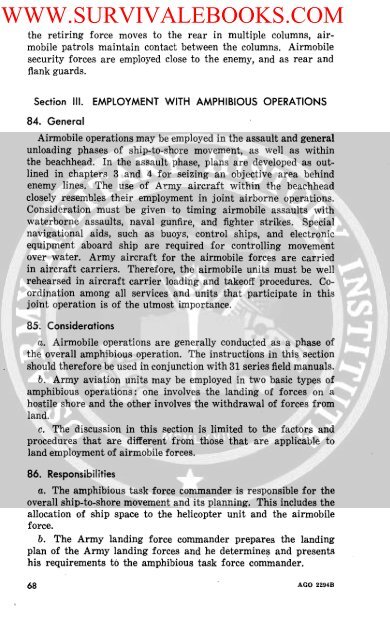FM 57-35 Airmobile Operations - Survival Books
FM 57-35 Airmobile Operations - Survival Books
FM 57-35 Airmobile Operations - Survival Books
- No tags were found...
Create successful ePaper yourself
Turn your PDF publications into a flip-book with our unique Google optimized e-Paper software.
WWW.SURVIVALEBOOKS.COMthe retiring force moves to the rear in multiple columns, airmobile patrols maintain contact between the columns. <strong>Airmobile</strong>security forces are employed close to the enemy, and as rear andflank guards.Section III. EMPLOYMENT WITH AMPHIBIOUS OPERATIONS84. General<strong>Airmobile</strong> operations may be employed in the assault and generalunloading phases of ship-to-shore movement, as well as withinthe beachhead. In the assault phase, plans are developed as outlined in chapters 3 and 4 for seizing an objective area behindenemy lines. The use of Army aircraft within the beachheadclosely resembles their employment in joint airborne operations.Consideration must be given to timing airmobile assaults withwaterborne assaults, naval gunfire, and fighter strikes. Specialnavigational aids, such as buoys, control ships, and electronicequipment aboard ship are required for controlling movementover water. Army aircraft for the airmobile forces are carriedin aircraft carriers. Therefore, the airmobile units must be wellrehearsed in aircraft carrier loading and takeoff procedures. Coordination among all services and units that participate in thisjoint operation is of the utmost importance.85. Considerationsa. <strong>Airmobile</strong> operations are generally conducted as a phase ofthe overall amphibious operation. The instructions in this sectionshould therefore be used in conjunction with 31 series field manuals.b. Army aviation units may be employed in two basic types ofamphibious operations: one involves the landing of forces on ahostile shore and the other involves the withdrawal of forces fromland.c. The discussion in this section is limited to the factors andprocedures that are different from those that are applicable toland employment of airmobile forces.86. Responsibilitiesa. The amphibious task force commander is responsible for theoverall ship-to-shore movement and its planning. This includes theallocation of ship space to the helicopter unit and the airmobileforce.6. The Army landing force commander prepares the landingplan of the Army landing forces and he determines and presentshis requirements to the amphibious task force commander.68 AG 2294B
















